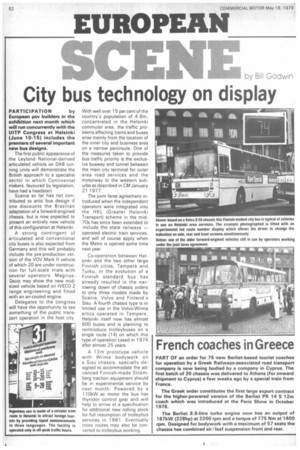by Bill Godwin
Page 54

If you've noticed an error in this article please click here to report it so we can fix it.
City bus technology on display
PARTICIPATION by European psv builders in the exhibition next month which will run concurrently with the UITP Congress at Helsinki (June 10-15) includes the premiere of several important new bus designs.
The first public appearance of the Leyland National-derived articulated vehicle on DAB running units will demonstrate the British approach to a specialist• sector in which Continental makers, favoured by legislation, have had a headstart.
Scania so far has not contributed to artic bus design if one discounts the Brazilian adaptation of a forward-engined chassis, but is now expected to present an entirely new vehicle of this configuration at Helsinki.
A strong contingent of articulated and conventional city buses is also expected from Germany and this will probably include the pre-production version of the VOV Mark II vehicle of which 20 are under construction for full-scale trials with several operators. MagirusDeutz may show the new midi sized vehicle based on IVECO Z range engineering and fitted with an air-cooled engine.
Delegates to the congress will have the opportunity to see something of the public transport operation in the host city. With well over 15 percent of the country's population of 4.8m, concentrated in the Helsinki commuter area, the traffic problems affecting trams and buses arise mainly from the location of the inner city and business area on a narrow peninsula. One of the measures taken to provide bus traffic priority is the exclusive busway and tunnel between the main city terminal for outer area road services and the motorway to the western suburbs as described in C/14 January 21 1977.
The joint fares agreement introduced when the independent operators were integrated into the HKL (Greater Helsinki Transport) scheme in the mid70s has since been extended to include the state railways — operated electric train services, and will of course apply when the Metro is opened some time next year
Co-operation between Helsinki and the two other large Finnish cities, Tampere and Turku, in the evolution of a Finnish standard bus has already resulted in the narrowing down of chassis orders to only three models made by Scania, Volvo and Finland's Sisu. A fourth chassis type is in limited use in the Volvo-Wilma artics operated in Tampere. Helsinki itself now has almost 600 buses and is planning to reintroduce trolleybuses on a single route (14) on which this type of operation cased in 1974 after almost 25 years.
A 12m prototype vehicle with VViima bodywork on a Sisu chassis, specially designed to accommodate the advanced Finnish-made Stromberg traction equipment should be in experimental service by next month. Powered by a 110kW ac motor the bus has thyristor control gear and will help to arrive at a specification for additional new rolling stock for full resumption of trolleybus services in 1981. Eventually more routes may also be converted to trolleybus working.




















































































































